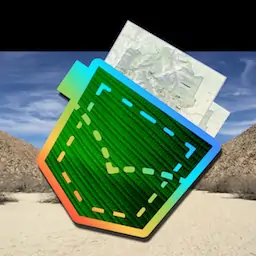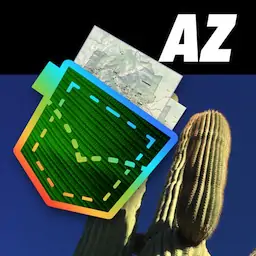"Scenics - Old Highway 180 and Petrified Wood" by U.S. National Park Service , public domain
Messages on StonePetrified Forest |
Messages on Stone - a Petroglyph brochure for Petrified Forest National Park (NP) in Arizona. Published by the National Park Service (NPS).
featured in
| National Parks Pocket Maps |  | |
| Arizona Pocket Maps |  |
Petrified Forest
National Park Service
U.S. Department of the Interior
Petrified Forest National Park
Arizona
Messages on Stone
Petroglyphs are like whispers from the past. For thousands of years, people of the Southwest have used
the surfaces of the boulders, canyon walls, and rock shelters as a means of communication. Petrified
Forest National Park contains hundreds of fine examples of these images pecked into stone.
What is a petroglyph?
Petroglyphs are images, symbols, or designs
that are scratched, pecked, carved, or
incised on natural rock surfaces. Created by
people hundreds, even thousands, of years
ago, petroglyphs intrigue us and provoke
many questions.
How are
petroglyphs made?
There are several possible techniques that
could have been used to make the park
petroglyphs. One method was using a direct
blow from an angular palm-sized rock
called a hammerstone. Another method,
indirect percussion, gave greater control by
using a chisel-like rock in conjunction with
the hammerstone.
What is that dark
surface on the rock?
The dark coating found on many rock
surfaces is a natural patina is formed of
iron and manganese oxides fixed with clay
particles by microorganisms—a sort of
weathering rind. Many petroglyphs are
made by pecking or scratching through this
thin patina to reveal the original color of
the interior of the rock. Eventually, the rock
coating redeposits, also called repatination,
darkening over time. Some researchers
hope that repatination may help with
dating petroglyphs.
How old are they?
Determining the age of petroglyphs is a
difficult task. Archeologists might assign
an age which correlates with a nearby
habitation site; evaluate the subject matter
and style to determine how it relates to a
specific time period; compare the sequence
of design layering; or use analytical dating
techniques such as X-ray fluorescence.
Most of the petroglyphs in the park are
thought to range between 600 to 1100 years
old, with a few older ones. The oldest dated
petroglyph in the park is 2000 years old.
The Hopi, Zuni, and Navajo of today
have centuries of historic connections
with this area, therefore different beliefs
and practices may be represented by the
petroglyphs. Researchers learn a great deal
from these living people. Some meanings
were not meant to be known or understood
today. Some meanings were not meant to
be known or understood by the uninitiated.
Some images were possibly made for
religious purposes and hold a deep spiritual
significance. They may be considered
prayers by some people.
Current speculation has led some
researchers to believe that various
petroglyphs may tell a story, mark a trail,
or commemorate an event. Some images
may have been made to ensure fertility
or successful hunting, or may have also
been used to keep track of the seasons. In
some instances the image may represent
a clan or family, many of which have been
recognized by their descendents. The
Hopi and Zuni have called the panels of
petroglyphs a reference library left by their
ancestors.
What do they mean?
Is that a poodle?
Researchers classify petroglyph and
pictograph (images painted with mineral
or vegetal pigment) styles according to
elements, figures, compositions, and
techniques that are consistent within a
geographic area and time period. Once a
style is defined, it may be used to associate
images with specific cultural groups. There
are very few pictographs in the park.
Archeologists have categorized the
petroglyphs found in the park into six
distinct groups: anthropomorph (human
form), zoomorph (animal shape), Katsina
(in Hopi) or Köko (in Zuni) are spirit
shape, hands/tracks, geometrics, and
indeterminate. Many shapes represented
by petroglyphs are familiar. Even the
geometric and abstract figures may remind
us of patterns in our own lives: water, stars,
clouds, and the passage of time.
Solar Calendar
masks appear in petroglyphs by 1300 CE
(Common Era) in this area. Katsinam are
spiritual beings who are part of the land,
bringing moisture to the Hopi villages and
Zuni.
Zoomorphs include large and small
animals, reptiles, and birds. You may
see cougars, birds, lizards, snakes, bats,
coyotes, and rabbits on the petroglyph
panels in the park. Hunters are sometimes
seen in conjunction with prey. Both animal
and some geometric symbols can be linked
to specific clans.
Geometrics consist of textile and pottery
designs, spirals, circles, straight and
wavy lines, “squiggle-mazes”, and other
geometric shapes. Often, the same patterns
are found in the artwork of living Pueblo
people, such as the Hopi and Zuni.
Anthropomorphs and spirits are
represented by the human form.
Anthropomorphic figures may have
complete bodies but generally lack facial
features. Hand and footprints appear on
many panels. Cultural items sometimes
associated with human figures include
rattles, dance wands, pahos (prayer sticks),
and ceremonial staffs. Katsina figures and
Periods associated with the different styles
of petroglyphs in Petrified Forest include
Basketmaker (500 BCE to 650 CE) and
Pueblo I, III, and IV (650-1450 CE). A few
Navajo petroglyphs have also been found
(1750 CE to the present). Unfortunately,
images on the petroglyph panels also
include modern additions.
The paved trail leading through Puerco
Pueblo ends at an overlook to view a small
circular petroglyph. Although it is not
as complex or elaborate as some of the
other images, this is a special petroglyph.
It marks the summer solstice. For about
a two week period around June 21, there
is an interaction of light and shadow that
passes across the rings of the petroglyph as
the sun rises. Rangers will be available in
the morning during the summer solstice at
Puerco Pueblo.
solar marker are found throughout the
park and beyond. While some mark the
summer solstice, others indicate winter
solstice and both equinoxes. Evidence also
indicates that some petroglyphs interact
forty-five days before and after the winter
solstice. Why did the ancestral Puebloan
people make these special symbols? Did
they have ceremonial purposes? Were
they calendars for planting for these
farming people? Researchers have many
theories and continue to learn from the
living indigenous people. The Zuni start
an important fasting period around the
summer solstice while the Hopi get ready
for the Niman, one of the most important
ceremonies of the year.
Archaeoastronomy is the term used to
describe the study of the heavens by the
ancient people. More petroglyphs and
pictographs such as the Puerco Pueblo
How to visit a
petroglyph site
A variety of factors contribute to the
erosion of petroglyphs including natural
forces such as wind, rain, extremes in
temperatures, plant growth, and rock
type. There may have been much older
petroglyphs left by Archaic people, now lost
to erosion. Perhaps the most devastating
factor is human. Vandalism of rock art sites
has escalated, including bullet holes, graffiti,
and removal of petroglyphs or entire
panels. Even the seemingly innocent touch
can harm petroglyphs. Oils and acids from
www.nps.gov/pefo
EXPERIENCE YOUR AMERICA
your hands can damage the petroglyphs
and desert varnish. For your own safety
and the preservation of the petroglyphs,
stay on the trails. Do not climb up or down
to the petroglyphs. Altering, defacing, or
damaging the petroglyphs is against the
law—even if the damage is unintentional.
Petroglyphs are fragile, non-renewable
cultural resources that, once damaged,
can never be replaced. Help protect and
preserve this rich cultural heritage.
April 2013


